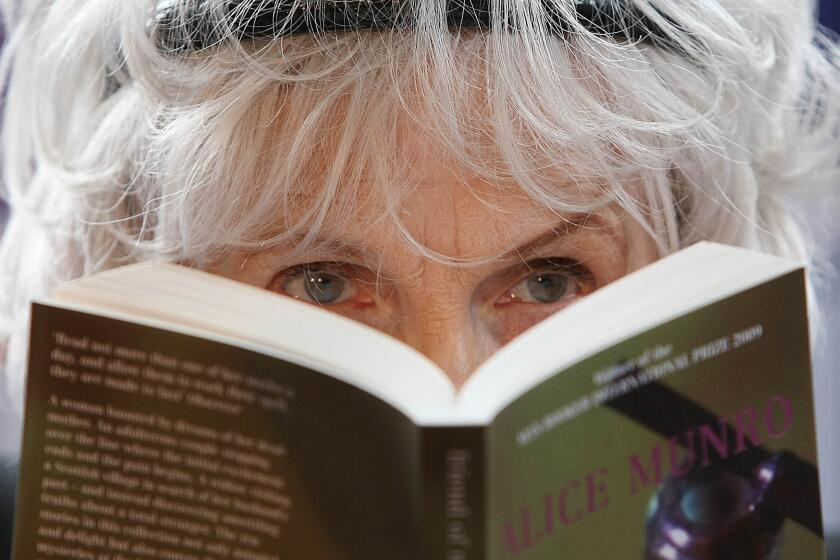In Search of Literary Genius : Former East Coast Publisher Sol Stein Comes West to Nurture Young Writers
Except for the Beverly Hills Hotel and a few obscure book tour stops, New Yorker Sol Stein had seen little of California before 1989.
But the man who founded the New York publishing house Stein & Day, edited Elia Kazan’s first novel, published the works of Dylan Thomas, wrote nine books and was a founding member with Tennessee Williams of the Playwrights Group at the Actors’ Studio has started to settle into the Southern California literary scene.
“I’ve toyed with the idea of moving here permanently,” said Stein, 64. “I don’t know, but I consider myself bi-coastal and suspect I will be spending more and more time here.”
Stein’s Southern California sojourn began when Stein’s friend Michael Feuers, an associate dean of university extension at UC Irvine, invited him to teach a course called “Dialogue for Writers.”
Stein agreed to leave his home that overlooks the Hudson River (the house featured in John Cheever’s short story “The Housebreaker of Shady Hill”) and move to Laguna Beach for several months last year.
The course was so successful that the students refused to let it end. They competed for 20 spots in an advanced seminar called “Chapter One” (members refer to themselves as “Sol Stein’s Southern California disciples”) by submitting an application and the first three pages of a novel. Some of the writers who were turned down tenaciously submitted new material.
The students “tell me there’s nothing like this,” said Stein. In typical writing classes or groups “you don’t get critiqued by someone who has nurtured best-selling writers.”
The group meets every week in Mission Viejo.
“One of my students is a genius, and there’s nothing like the experience of that kind of discovery,” said Stein. “I used to publish 100 books a year, and only four or five gave me that kind of pleasure.”
(His publishing house, founded in 1962 with his wife, Patricia Day, was lost to bankruptcy in 1987 when a dispute with a distributor led to cash-flow problems.)
Stein returned to his Scarborough home recently but promises to stay in contact with the group and plans to be back here in November to teach.
It’s not the money that lures him West.
“Here I’m working for minimum wage,” said the author, who says he charges $225 an hour to doctor books in the East, “but I do it for the pay-back. From the best students, I get as much as I give.”
Stein gives a lot, say his students, who by occupation include a former policewoman, a Marine colonel, a professor of philosophy and an obstetrician.
Leland Pound, chief financial officer of Baker Communications in Palos Verdes, took Stein’s extension class last year and is a member of Chapter One, paying $98 a month for Stein’s tutelage. Pound said he has studied under many writing instructors, has attended numerous workshops and has read books on writing. But he said he’s learned more from Stein than from all of those experiences combined.
“There are lots of writers’ groups out there, but it’s kind of like people who are not yet published trying to teach others not yet published,” said Pound. “You end up with some good comments but also some really bad ones.”
Pound, who is editing his completed novel, said it’s unusual to find someone with as much experience as Stein who is willing to work with novice writers for little pay.
“He genuinely wants to bring you along and see you have a chance to make it,” Pound said. “He’s written his own books plus worked with the top names in the field. He’s an author and a publisher. It’s really quite an honor to work with him.”
Stein also indirectly teaches more than 1,000 California writers through a computer tutorial program called WritePro.
The idea for the program germinated on the July 4 weekend in 1987, when Stein’s daughter and her boyfriend persuaded him to buy a computer.
“Within a couple of weeks after I got it, I realized the computer enabled me to do something I had been doing for 36 years (and do it) much more effectively--teach writers, one at a time,” he said. “Through the computer, I could clone myself. It opened a whole new horizon.”
Stein has sold 20,000 copies of the tutorial program to writers in 37 countries, with the largest contingent in California, he said. WritePro was the first software offered by three mail-order book clubs--the Literary Guild, the Doubleday Book Club and Barnes & Noble.
“Nobody has ever had so many writing students at one time,” he said. “It’s also being used by nonfiction writers and journalists to make their nonfiction more readable.”
The program includes lessons on provocative dialogue, cliche-hunting, suspenseful openings and dramatic conflict. It emphasizes rewriting, a task Stein knows all too well.
His 10th book, “The Best Revenge,” a novel to be published by Random House in July, took a decade and 13 drafts to complete. (Most of his books take about two years.) The novel, a story about two men and backstage rackets on Broadway, is slightly autobiographical. He says it’s a book that was “stewing” in him.
“I always ask my students what is the one secret that they really don’t want anyone to know about,” he said. “It’s the process of digging into your own life for hidden things. (‘The Best Revenge’) is full of the kind of snapshots you don’t want your neighbors to see.”
Stein said it is his most meaningful work.
“In a way, it’s really a book of secrets,” he said. “I used the environment in Little Italy (in Chicago), where you could buy a life for $5, where someone got tossed out of a third-floor window and landed on spikes and even the cops wouldn’t come and take the guy off until he died. It is central to my whole experience of life.”
Stein said “very dramatic” experiences occurred when his father, a Russian immigrant who was a very successful jewelry designer in Chicago, fell on hard times during the Depression. The family moved from a “splendid home” in Chicago to a room in a Harlem apartment when Stein was 4.
“During the depths of the Depression, I wrote stories on telegram blanks that my father used to pick up from Grand Central Station because we couldn’t afford pads.”
At 12, he was performing magic shows; at 13, he wrote a nonfiction book on the subject and sent it to a publisher, who called him for a meeting. When the young boy arrived, the astonished publisher said: “Why didn’t your father come himself?”
The book was published when Stein was 15, the same year he entered City College in New York after skipping three school grades. Another book, also about magic, was published the following year.
During World War II, Stein entered the 1st Infantry Division, also known as the “Big Red One.” He was appointed commandant of occupational training schools in the American zone of Germany; that led to a teaching job after the war at City College, where he finished his degree.
In the 1950s, Stein began publishing poetry and essays in national magazines and writing plays that were produced in California, Washington, D.C., and on Broadway.
Stein described his transition from playwright to novelist as having taken place by accident. A play of his was to be produced in London, but a squabble between the producer, star and director turned into a melee. Stein retreated to his study and in 17 days rewrote the play into a novel. It was published under the title “The Husband.”
His second novel, “The Magician,” was a bestseller that was published in “every language that counts,” he said. “I found the world of fiction hospitable.”
In its 25 years in business, Stein & Day published the works of the Shah of Iran, British Prime Minister Edward Heath, Steve Allen, F. Lee Bailey and Desmond Morris.
In 1987, the company filed for Chapter 11 bankruptcy. Unable to persuade major creditors to allow the firm to resume publishing, it closed, losing $2.8 million, including the company’s headquarters, an 11-acre estate in Briarcliff Manor, just north of New York City.
Once the lawyers--”the hired guns of the law”--took over, Stein & Day “was never permitted to publish another book,” Stein wrote in his nonfiction book, “A Feast for Lawyers: Inside Chapter 11.”
“Fewer than a dozen books escaped the judicial net woven around the company. . . . In effect, the inept judicial system bears a major part of the blame for causing what may have been the biggest long-term suppression of books in the United States.”
Stein still lectures on the subject of bankruptcy.
“I’m kind of an authority on the subject,” he said. “It follows me like a plague.”
More to Read
Sign up for our Book Club newsletter
Get the latest news, events and more from the Los Angeles Times Book Club, and help us get L.A. reading and talking.
You may occasionally receive promotional content from the Los Angeles Times.






